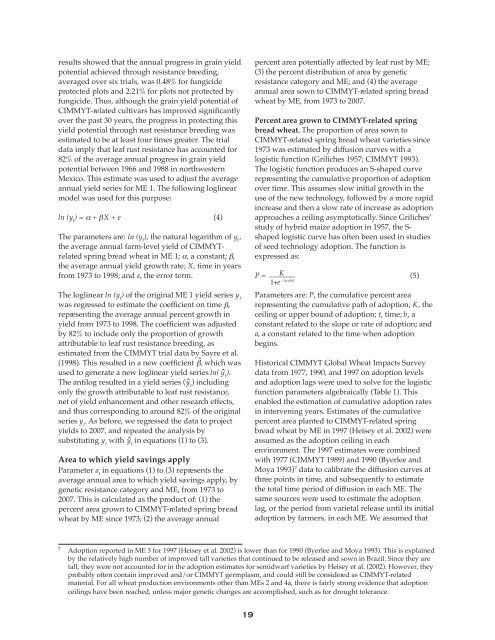The Economic Impact in Developing Countries of ... - AgEcon Search
The Economic Impact in Developing Countries of ... - AgEcon Search
The Economic Impact in Developing Countries of ... - AgEcon Search
- No tags were found...
Create successful ePaper yourself
Turn your PDF publications into a flip-book with our unique Google optimized e-Paper software.
esults showed that the annual progress <strong>in</strong> gra<strong>in</strong> yieldpotential achieved through resistance breed<strong>in</strong>g,averaged over six trials, was 0.48% for fungicideprotected plots and 2.21% for plots not protected byfungicide. Thus, although the gra<strong>in</strong> yield potential <strong>of</strong>CIMMYT-related cultivars has improved significantlyover the past 30 years, the progress <strong>in</strong> protect<strong>in</strong>g thisyield potential through rust resistance breed<strong>in</strong>g wasestimated to be at least four times greater. <strong>The</strong> trialdata imply that leaf rust resistance has accounted for82% <strong>of</strong> the average annual progress <strong>in</strong> gra<strong>in</strong> yieldpotential between 1966 and 1988 <strong>in</strong> northwesternMexico. This estimate was used to adjust the averageannual yield series for ME 1. <strong>The</strong> follow<strong>in</strong>g logl<strong>in</strong>earmodel was used for this purpose:ln (y t) = α + βX + ε (4)<strong>The</strong> parameters are: ln (y t), the natural logarithm <strong>of</strong> y t,the average annual farm-level yield <strong>of</strong> CIMMYTrelatedspr<strong>in</strong>g bread wheat <strong>in</strong> ME 1; α, a constant; β,the average annual yield growth rate; X, time <strong>in</strong> yearsfrom 1973 to 1998; and ε, the error term.<strong>The</strong> logl<strong>in</strong>ear ln (y t) <strong>of</strong> the orig<strong>in</strong>al ME 1 yield series y twas regressed to estimate the coefficient on time β,represent<strong>in</strong>g the average annual percent growth <strong>in</strong>yield from 1973 to 1998. <strong>The</strong> coefficient was adjustedby 82% to <strong>in</strong>clude only the proportion <strong>of</strong> growthattributable to leaf rust resistance breed<strong>in</strong>g, asestimated from the CIMMYT trial data by Sayre et al.(1998). This resulted <strong>in</strong> a new coefficient ˆβ, which wasused to generate a new logl<strong>in</strong>ear yield series ln( ŷ t).<strong>The</strong> antilog resulted <strong>in</strong> a yield series ( ŷ t) <strong>in</strong>clud<strong>in</strong>gonly the growth attributable to leaf rust resistance,net <strong>of</strong> yield enhancement and other research effects,and thus correspond<strong>in</strong>g to around 82% <strong>of</strong> the orig<strong>in</strong>alseries y t. As before, we regressed the data to projectyields to 2007, and repeated the analysis bysubstitut<strong>in</strong>g y twith ŷ t<strong>in</strong> equations (1) to (3).Area to which yield sav<strong>in</strong>gs applyParameter a t<strong>in</strong> equations (1) to (3) represents theaverage annual area to which yield sav<strong>in</strong>gs apply, bygenetic resistance category and ME, from 1973 to2007. This is calculated as the product <strong>of</strong>: (1) thepercent area grown to CIMMYT-related spr<strong>in</strong>g breadwheat by ME s<strong>in</strong>ce 1973; (2) the average annualpercent area potentially affected by leaf rust by ME;(3) the percent distribution <strong>of</strong> area by geneticresistance category and ME; and (4) the averageannual area sown to CIMMYT-related spr<strong>in</strong>g breadwheat by ME, from 1973 to 2007.Percent area grown to CIMMYT-related spr<strong>in</strong>gbread wheat. <strong>The</strong> proportion <strong>of</strong> area sown toCIMMYT-related spr<strong>in</strong>g bread wheat varieties s<strong>in</strong>ce1973 was estimated by diffusion curves with alogistic function (Griliches 1957; CIMMYT 1993).<strong>The</strong> logistic function produces an S-shaped curverepresent<strong>in</strong>g the cumulative proportion <strong>of</strong> adoptionover time. This assumes slow <strong>in</strong>itial growth <strong>in</strong> theuse <strong>of</strong> the new technology, followed by a more rapid<strong>in</strong>crease and then a slow rate <strong>of</strong> <strong>in</strong>crease as adoptionapproaches a ceil<strong>in</strong>g asymptotically. S<strong>in</strong>ce Griliches’study <strong>of</strong> hybrid maize adoption <strong>in</strong> 1957, the S-shaped logistic curve has <strong>of</strong>ten been used <strong>in</strong> studies<strong>of</strong> seed technology adoption. <strong>The</strong> function isexpressed as:P = –––––––K(5)1+e -(a+bt)Parameters are: P, the cumulative percent arearepresent<strong>in</strong>g the cumulative path <strong>of</strong> adoption; K, theceil<strong>in</strong>g or upper bound <strong>of</strong> adoption; t, time; b, aconstant related to the slope or rate <strong>of</strong> adoption; anda, a constant related to the time when adoptionbeg<strong>in</strong>s.Historical CIMMYT Global Wheat <strong>Impact</strong>s Surveydata from 1977, 1990, and 1997 on adoption levelsand adoption lags were used to solve for the logisticfunction parameters algebraically (Table 1). Thisenabled the estimation <strong>of</strong> cumulative adoption rates<strong>in</strong> <strong>in</strong>terven<strong>in</strong>g years. Estimates <strong>of</strong> the cumulativepercent area planted to CIMMYT-related spr<strong>in</strong>gbread wheat by ME <strong>in</strong> 1997 (Heisey et al. 2002) wereassumed as the adoption ceil<strong>in</strong>g <strong>in</strong> eachenvironment. <strong>The</strong> 1997 estimates were comb<strong>in</strong>edwith 1977 (CIMMYT 1989) and 1990 (Byerlee andMoya 1993) 7 data to calibrate the diffusion curves atthree po<strong>in</strong>ts <strong>in</strong> time, and subsequently to estimatethe total time period <strong>of</strong> diffusion <strong>in</strong> each ME. <strong>The</strong>same sources were used to estimate the adoptionlag, or the period from varietal release until its <strong>in</strong>itialadoption by farmers, <strong>in</strong> each ME. We assumed that7Adoption reported <strong>in</strong> ME 3 for 1997 (Heisey et al. 2002) is lower than for 1990 (Byerlee and Moya 1993). This is expla<strong>in</strong>edby the relatively high number <strong>of</strong> improved tall varieties that cont<strong>in</strong>ued to be released and sown <strong>in</strong> Brazil. S<strong>in</strong>ce they aretall, they were not accounted for <strong>in</strong> the adoption estimates for semidwarf varieties by Heisey et al. (2002). However, theyprobably <strong>of</strong>ten conta<strong>in</strong> improved and/or CIMMYT germplasm, and could still be considered as CIMMYT-relatedmaterial. For all wheat production environments other than MEs 2 and 4a, there is fairly strong evidence that adoptionceil<strong>in</strong>gs have been reached, unless major genetic changes are accomplished, such as for drought tolerance.19
















